元基因组驱动的食物中难培养物种的分离
IF 4.5
1区 农林科学
Q1 BIOTECHNOLOGY & APPLIED MICROBIOLOGY
引用次数: 0
摘要
虽然从食物微生物群中分离微生物似乎没有从肠道或环境来源中分离微生物那么具有挑战性,但从食物中恢复所有具有代表性的物种仍然是一项艰巨的任务。在这里,我们通过宏基因组分析表明,在之前的10种奶酪研究中,一些丰富的物种逃脱了分离,包括一些以前未被表征的物种。这凸显了实现从食物中全面回收微生物的持续挑战。为了解决这一差距,我们设计了一种新的策略,将基于宏基因组学的探针靶向感兴趣的物种,再加上使用汇集样本的增量培养方法。为了证明这一概念,我们将这一策略应用于两种奶酪中,这些奶酪中含有我们之前研究中未分离的物种,目的是分离出含量高于2%的所有物种,特别是潜在的新食物物种。通过这种方法,我们成功地从第一种奶酪中分离出两种冷杆菌和两种弧菌,从第二种奶酪中分离出四种盐单胞菌和两种假互变单胞菌。值得注意的是,据我们所知,P. undina和V. litoralis代表了这些物种的第一个乳酪分离株。然而,我们无法分离到一种新的假互单胞菌,迄今为止没有表征的代表,以及以前从海洋环境中分离到的叶状Marinomonas。利用宏基因组组装基因组(MAGs)和宏基因组分析,我们讨论了它们无法恢复的可能原因。最后,该策略提供了一种有希望的方法来分离一组代表食品生态系统中微生物多样性的菌株。这些分离株可作为调查其在菌落中的作用、对产品开发的影响、安全性影响及其在发酵剂开发中的潜力的基础。本文章由计算机程序翻译,如有差异,请以英文原文为准。

Metagenomic driven isolation of poorly culturable species in food
Although isolating microorganisms from food microbiota may appear less challenging than from the gut or environmental sources, recovering all representative species from food remains a difficult task. Here, we showed by metagenomic analysis that several abundant species had escaped isolation in a previous study of ten cheeses, including several previously uncharacterized species. This highlights the ongoing challenge of achieving a comprehensive recovery of microbes from food. To address this gap, we designed a novel strategy integrating metagenomics-based probes targeting the species of interest, coupled with an incremental culturing approach using pooled samples. As proof of concept, we applied this strategy to two cheeses containing species that were not isolated in our previous study, with the objective of isolating all species present at levels above 2% and, in particular, potential novel food species. Through this approach, we successfully performed the targeted isolation of two Psychrobacter and two Vibrio species from the first cheese, and four Halomonas and two Pseudoalteromonas species from the second one. Notably, P. undina and V. litoralis represented, as far as we know, the first cheese isolates characterized for these species. However, we were unable to isolate a novel species of Pseudoalteromonas, with no characterized representative to date, and Marinomonas foliarum, previously isolated from marine environment. Using metagenome-assembled genomes (MAGs) and metagenomic analysis, we discussed the possible reasons for their non-recovery. Finally, this strategy offers a promising approach for isolating a set of strains representative of the microbial diversity present in food ecosystems. These isolates can serve as a basis for investigating their roles in the communities, their impact on product development, safety implications and their potential in the development of starter cultures.
求助全文
通过发布文献求助,成功后即可免费获取论文全文。
去求助
来源期刊

Food microbiology
工程技术-生物工程与应用微生物
CiteScore
11.30
自引率
3.80%
发文量
179
审稿时长
44 days
期刊介绍:
Food Microbiology publishes original research articles, short communications, review papers, letters, news items and book reviews dealing with all aspects of the microbiology of foods. The editors aim to publish manuscripts of the highest quality which are both relevant and applicable to the broad field covered by the journal. Studies must be novel, have a clear connection to food microbiology, and be of general interest to the international community of food microbiologists. The editors make every effort to ensure rapid and fair reviews, resulting in timely publication of accepted manuscripts.
 求助内容:
求助内容: 应助结果提醒方式:
应助结果提醒方式:


